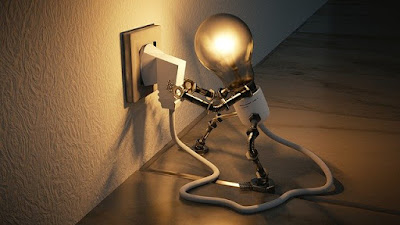Before the discovery of electrons, electricity had no
definition. Even as late as 1915 physics textbooks were unable to define it. One
thing was believed, however: the current always flows from the positive pole to
the negative pole.
When the electron became better understood it was definitely
proved to be a negative charge of electricity – a negative flow, as it were,
from the negative pole to the positive something like the cathode ray.
The fact of the matter then is this: actually the electric
current travels from the negative to the positive which is contrary to the
former belief. In most physics books you will still find the statement that the
current flows from the positive to the negative: this is purely a convention for
the sake of convenience since for so many years it had been considered to be
so. Of course, it is merely a difference in terminology.
We speak of electricity flowing along a conductor and a
comparison between this flow and the flow of water is often made. The analogy
is by no means exact but it is helpful.
Water will only flow from a higher to a lower level since it
cannot flow uphill. The greater the difference in level between two tanks
connected by a pipe, the greater will be the force of the flow of water in that
pipe.
For want of a better word let us call the difference in level
between the two tanks a difference of potential. We saw that potential energy
is energy that is pent up and ready to be transformed into kinetic energy. It
may be seen then that the higher tank has a higher potential than the lower
tank.
Now in an electric current, the rate of the flow is dependent
upon the difference in electrical potential between the positive and negative
poles.
If the difference of electrical potential between the
positive pole and the negative pole is considerable there will be a strong
force or current flowing in the wire connecting those poles. The difference in
potential is in reality similar to the difference between the two tanks of
water in their respective elevations.
The moving force or motive power of this electric current is
called the electromotive force. It has nothing whatever to do with the quantity
of current for it merely tells the motive force. It indicates the potential
difference. This e.m.f. is always measured in volts.
The quantity of electricity that passes a given point in a
given time is known as the current strength and is measured in amperes. A
certain unit of electricity is called a coulomb and an ampere is roughly
defined as the amount of current necessary for one coulomb per second.
We then have the electromotive force which is measured in
volts and is the difference of potential between opposite poles, and the
current strength which is the number of electrons passing a given point in a
given time.
It may be noted that volts and amperes are named after their
discoverers: Alessandria Volta, an Italian physicist; and André Ampere, a
French physicist.
Just as in studying motion, we saw that friction opposes
motion. So in electricity or electrical movement, we find resistance opposing
the flow of current. Different conductors offer different resistances to an
electric current; and the higher the resistance which a conductor offers to the
flow of electricity, the poorer will be its ability to conduct the current.
Conductors like silver and copper which offer very little
resistance are the best conductors of electricity. Resistance is measured in
ohms. A volt is defined as the electromotive force which steadily applied to a
conductor whose resistance is 1 ohm, will produce a current of 1 ampere.
Electromotive force is the force
causing the flow of electricity.
Current is the rate of flow of electricity.
Resistance is the opposition to this flow.
A fundamental and important law of the electric current known
as Ohm’s is that current equals the electromotive force divided by the total
resistance. Knowing the relationship between these three quantities, it is easy
if you know two of them to find the third.
For example, the current in your home can easily be found
when you are told that the voltage is 110 and the resistance to the current is
220 ohms. The current is therefore a half an ampere. Ohm’s law may be written
as follows:
Current =
e.m.f/resistance
I = E/R
Or
I= V/R
Tags
technology



